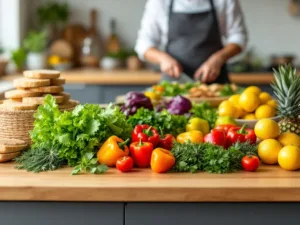How to Prepare Healthy Food Using Only Natural Ingredients: A Comprehensive Guide to Wholesome Eating
Introduction
In a world increasingly dominated by processed foods and artificial additives, the quest for healthier eating habits has never been more urgent. The modern diet, laden with preservatives, refined sugars, and synthetic flavors, has been linked to a host of health issues, including obesity, diabetes, and heart disease. As awareness grows, more people are turning to natural ingredients as a way to nourish their bodies and improve their overall well-being. But what does it truly mean to prepare healthy food using only natural ingredients? This article delves into the principles of natural cooking, offering practical tips, recipes, and insights to help you transform your kitchen into a haven of wholesome, nutritious meals.
The Importance of Natural Ingredients
What Are Natural Ingredients?
Natural ingredients are those that are minimally processed and free from artificial additives. They include whole foods like fruits, vegetables, grains, nuts, seeds, and lean proteins. These ingredients are as close to their natural state as possible, retaining their nutritional value and inherent flavors.
Benefits of Natural Ingredients
- Nutritional Value: Natural ingredients are rich in essential nutrients, including vitamins, minerals, antioxidants, and fiber. These nutrients are crucial for maintaining good health, boosting immunity, and preventing chronic diseases.
- No Harmful Additives: Unlike processed foods, natural ingredients do not contain artificial preservatives, colors, or flavors. This reduces the risk of adverse health effects associated with these additives.
- Better Digestion: Whole foods are easier for the body to digest and absorb. They promote a healthy gut microbiome, which is essential for overall health.
- Sustainability: Choosing natural, locally-sourced ingredients supports sustainable farming practices and reduces the environmental impact of food production.
Planning Your Natural Kitchen
Stocking Your Pantry
A well-stocked pantry is the foundation of healthy cooking. Here are some essential natural ingredients to keep on hand:
- Whole Grains: Brown rice, quinoa, oats, whole wheat flour, and barley.
- Legumes: Lentils, chickpeas, black beans, and kidney beans.
- Nuts and Seeds: Almonds, walnuts, chia seeds, flaxseeds, and sunflower seeds.
- Healthy Oils: Olive oil, coconut oil, and avocado oil.
- Herbs and Spices: Basil, oregano, turmeric, cumin, and cinnamon.
- Natural Sweeteners: Honey, maple syrup, and dates.
- Fresh Produce: A variety of fruits and vegetables, preferably organic and seasonal.
Essential Kitchen Tools
Having the right tools can make natural cooking more efficient and enjoyable. Consider investing in:
- High-Quality Knives: For chopping, slicing, and dicing.
- Blender or Food Processor: For making smoothies, soups, and sauces.
- Cast Iron Skillet: For even cooking and added iron to your diet.
- Steamer Basket: For preserving nutrients in vegetables.
- Glass Containers: For storing leftovers and meal prepping.
Principles of Natural Cooking
Focus on Whole Foods
The cornerstone of natural cooking is the use of whole foods. These are foods that are unprocessed or minimally processed, retaining their natural nutrients and flavors. Instead of reaching for a box of pre-packaged meals, opt for fresh produce, whole grains, and lean proteins.
Minimize Processing
Processing often strips foods of their nutrients and adds unhealthy additives. When preparing meals, aim to keep ingredients as close to their natural state as possible. For example, instead of using canned vegetables, choose fresh or frozen options.
Use Healthy Cooking Methods
The way you cook your food can impact its nutritional value. Some of the healthiest cooking methods include:
- Steaming: Preserves nutrients and keeps vegetables crisp.
- Grilling: Adds flavor without the need for excessive oils.
- Baking: A low-fat method that retains moisture and flavor.
- Sautéing: Uses minimal oil and cooks food quickly to preserve nutrients.
Flavor with Herbs and Spices
Instead of relying on salt, sugar, and artificial flavorings, use herbs and spices to enhance the taste of your dishes. Not only do they add depth and complexity, but many herbs and spices also have health benefits. For example, turmeric has anti-inflammatory properties, while garlic can boost immunity.
Practical Tips for Preparing Healthy Meals
Start with a Balanced Plate
A balanced meal should include a variety of food groups to ensure you’re getting a wide range of nutrients. Aim to fill half your plate with vegetables, a quarter with lean protein, and a quarter with whole grains. Add a small portion of healthy fats, such as avocado or olive oil, to complete the meal.
Meal Prepping
Meal prepping is a great way to ensure you have healthy, natural meals ready to go throughout the week. Dedicate a few hours each week to preparing and portioning out meals. This can include chopping vegetables, cooking grains, and preparing proteins. Store these components in glass containers and mix and match throughout the week to create different meals.
Snack Smart
Healthy snacking can help keep your energy levels stable throughout the day. Opt for natural snacks like fresh fruit, raw nuts, or vegetable sticks with hummus. Avoid processed snacks like chips and cookies, which are often high in unhealthy fats and sugars.
Hydrate Naturally
Staying hydrated is essential for overall health. Instead of sugary drinks or artificial beverages, opt for water, herbal teas, or naturally flavored water with slices of citrus, cucumber, or mint.
Recipes Using Natural Ingredients
Breakfast: Quinoa Breakfast Bowl
Ingredients:
- 1 cup cooked quinoa
- 1/2 cup almond milk
- 1 tablespoon honey or maple syrup
- 1/2 teaspoon cinnamon
- Fresh berries and nuts for topping
Instructions:
- In a small pot, combine cooked quinoa, almond milk, honey, and cinnamon.
- Heat over medium heat until warm.
- Pour into a bowl and top with fresh berries and nuts.
Lunch: Grilled Chicken and Vegetable Salad
Ingredients:
- 1 grilled chicken breast, sliced
- Mixed greens (spinach, arugula, kale)
- Cherry tomatoes, halved
- Cucumber, sliced
- Avocado, diced
- Olive oil and lemon juice for dressing
Instructions:
- In a large bowl, combine mixed greens, cherry tomatoes, cucumber, and avocado.
- Top with sliced grilled chicken.
- Drizzle with olive oil and lemon juice, then toss to combine.
Dinner: Baked Salmon with Steamed Vegetables
Ingredients:
- 1 salmon fillet
- 1 tablespoon olive oil
- 1 teaspoon dill
- Salt and pepper to taste
- Assorted vegetables (broccoli, carrots, zucchini)
Instructions:
- Preheat the oven to 375°F (190°C).
- Place the salmon fillet on a baking sheet lined with parchment paper.
- Drizzle with olive oil and sprinkle with dill, salt, and pepper.
- Bake for 15-20 minutes, or until the salmon is cooked through.
- While the salmon is baking, steam the vegetables until tender.
- Serve the salmon with the steamed vegetables on the side.
Snack: Homemade Trail Mix
Ingredients:
- 1 cup raw almonds
- 1/2 cup walnuts
- 1/2 cup pumpkin seeds
- 1/2 cup dried cranberries
- 1/2 cup dark chocolate chips (at least 70% cocoa)
Instructions:
- In a large bowl, combine all ingredients.
- Mix well and store in an airtight container.
Overcoming Common Challenges
Time Constraints
One of the biggest challenges people face when trying to cook with natural ingredients is time. However, with proper planning and meal prepping, it’s possible to incorporate healthy cooking into a busy schedule. Dedicate a few hours each week to preparing ingredients and cooking meals in bulk. This will save time during the week and ensure you always have healthy options on hand.
Budget Concerns
Another common concern is the cost of natural ingredients. While some organic products can be more expensive, there are ways to eat healthily on a budget. Buy in bulk, choose seasonal produce, and consider growing your own herbs and vegetables. Additionally, planning meals and avoiding food waste can help stretch your budget further.
Taste Preferences
Transitioning to a diet based on natural ingredients may require an adjustment period, especially if you’re used to the strong flavors of processed foods. Start by gradually incorporating more whole foods into your diet and experimenting with different herbs and spices to find flavors you enjoy. Over time, your taste buds will adapt, and you may find that you prefer the natural taste of fresh ingredients.
Conclusion
Preparing healthy food using only natural ingredients is not just a trend; it’s a lifestyle choice that can have profound effects on your health and well-being. By focusing on whole foods, minimizing processing, and using healthy cooking methods, you can create meals that are both nutritious and delicious. While there may be challenges along the way, the benefits of eating naturally far outweigh the drawbacks. With proper planning, a well-stocked pantry, and a willingness to experiment, you can transform your kitchen into a place of wholesome, natural cooking. So, take the first step today and start your journey towards a healthier, more natural way of eating. Your body will thank you.









Add comment